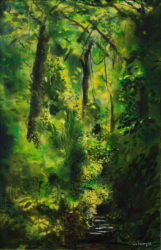Artists Stanley Greaves AA and Akima McPherson’s conversation this month surrounds Ron Savory’s acrylic painting, Forest Path Night Fall, which he completed in 1996.
Stanley Greaves: Most landscape paintings deal with views of the coastland and Georgetown urban scenes. Savory had spent time as a civil servant at Kamarang where his total immersion in the rain-forest environment provided a rich variety of scenes. He certainly could be considered a pioneer in this genre of painting.
There is no escaping the greenness of the rainforest that is everywhere, which some might view as being monotonous, but Savory in Forest Path, Nightfall has disproved this in the subtle handling of his paints.

Ron Savory
Acrylic
1996
(Photo courtesy of the National Gallery of Art, Castellani House)
Akima McPherson: I admit Forest Path, Nightfall is a favourite Savory piece of mine. Standing before it I feel like I am in the bush – as we say, and that every step will take me deeper and deeper into the mysterious belly of the forest. I hear birds off in the distance and fear I may hear rustling at ground-level near my feet. It does allow my imagination to be un-reigned while my body remains in the Gallery. I remember as an art student the experience of painting the landscape… Only then did I realise how many different greens characterise a scene. This excites me about the Savory piece; the range of greens he employs. I like how he has also not laboured the leaves but allowed areas of colour which he minimally defines with leaf-like forms.
SG: It is undoubtedly the finest Savory painting I have seen. My appreciation is based on numerous trips to the interior immersing myself in the environment. There is a freedom in his composition not seen in earlier rainforest presentations. One senses a deeper involvement with the actuality of paint itself and not just a means to an end. There is undoubted power in using a limited palette. In this case we have luminous greens linked with free brushwork. One senses an artist in command of theme and intention to create the effects witnessed. The lyrical quality of the work creates parallel in my mind to listening to music. Savory himself was very knowledgeable about musical forms both classical and jazz and did produce radio programmes while working at Guyana Broadcasting Corporation.
AM: To me the lyrical quality is in the natural sounds the image proposes; is this what you mean? And you state, “One senses a deeper involvement with the actuality of paint itself and not just a means to an end.” Please explain this as I suspect I have the wrong end of the stick here – I’m understanding you to mean Savory’s marks evidence a variety of gestures (small and grand etc) in painting the picture.
SG: Actuality of paint refers to being as much concerned with exploring its physical quality as with what it will portray. Some artists are more concerned with the latter, with the theme being explored. Being more concerned with its physical quality led to the Abstract Expressionist School – paint as paint with an appeal to feelings as in the way we listen to music. Lyrical quality has some reference to both music and some forms of poetry where the accent is on feeling responses, moving from the physical eye to the spiritual.




